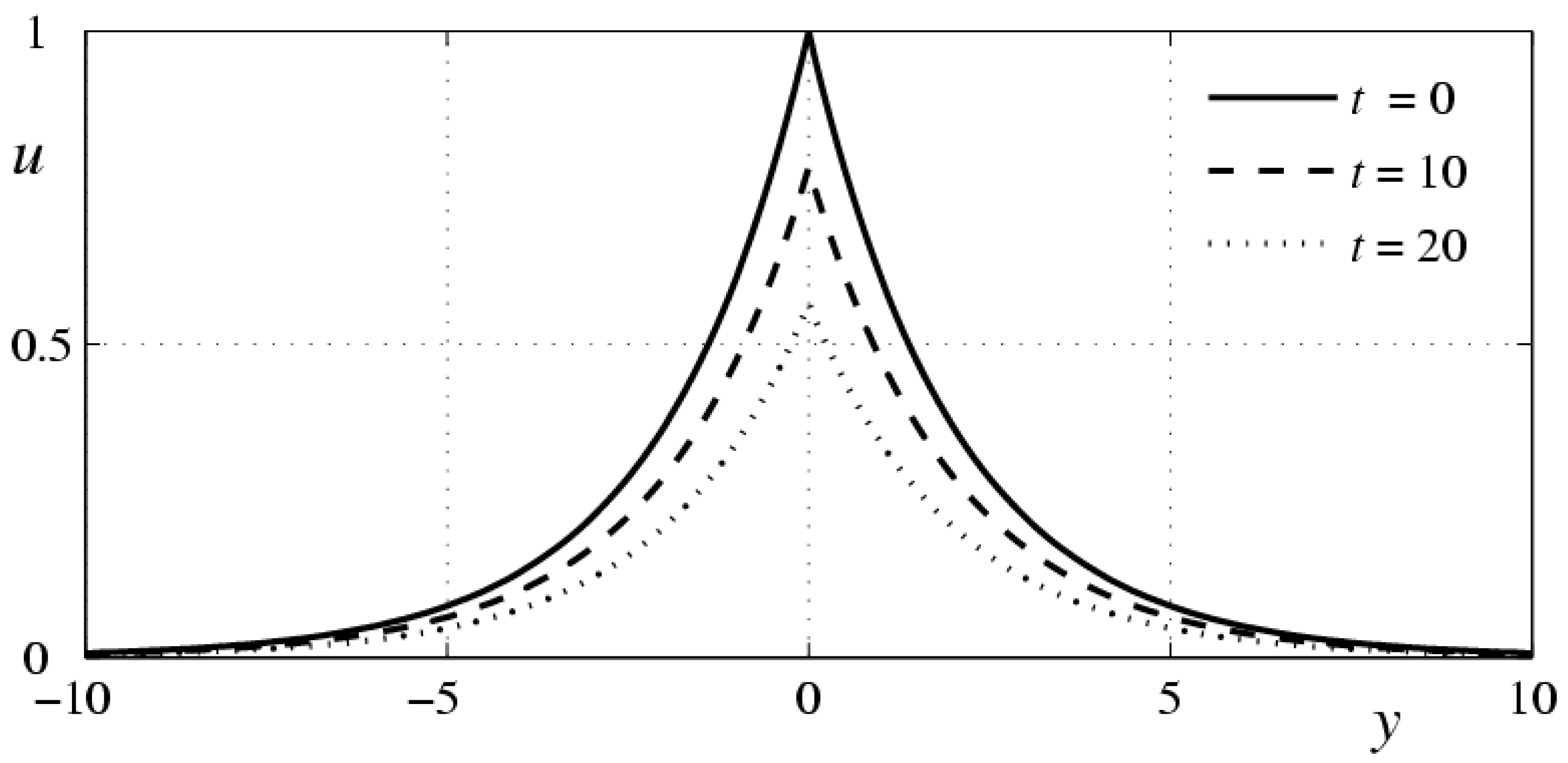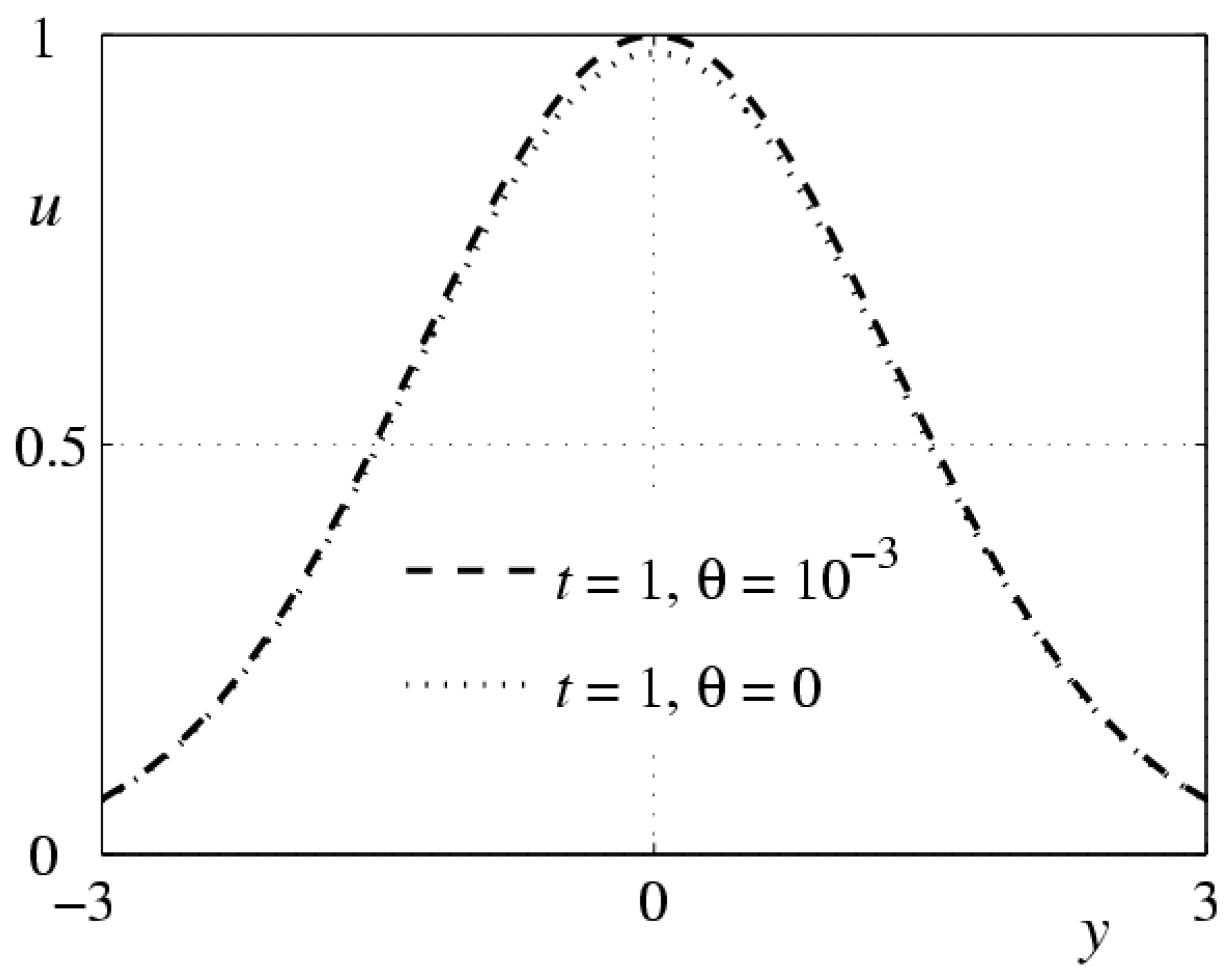Analysis of the Models of Motion of Aqueous Solutions of Polymers on the Basis of Their Exact Solutions
Abstract
:1. Introduction
2. Theoretical-Group Properties of Considered Models
3. Motions with Straight-Line or Circular Trajectories
4. Motion in a Half-Space Induced by Plane Rotation
5. Motions in Cylindrical Tubes
6. Concluding Remarks
- The phenomenological model of polymer solution motion formulated in Reference [12] contains two additional parameters as compared to the classical Navier-Stokes equations: relaxation time and relaxation viscosity . The first parameter can be found from experiments that are not dealing with the laminar-turbulent transition. Unfortunately, we are not aware of any reliable methods of determining the second parameter. The same problem persists if the simplified model (2), (5) is used. However, it is not a priori preferable as compared to model (2), (6), where the convective derivative of the tensor is replaced by its objective derivative . This dilemma could be resolved by performing an experiment where the polymer solution flows in a sufficiently long round tube under the action of a constant pressure gradient. In the first model, the classical Poiseuille flow is formed, where the pressure is independent of the radial coordinate. In the second model, Equation (40) predicts the difference in the pressures at the tube wall and at the tube axis: . It is of interest that this effect is manifested in steady motion of the fluid.
- Another specific feature of model (2), (6) is the absence of an unsteady analog of the Poiseuille flow with an arbitrary dependence of the pressure gradient on time. Indeed, if the function in Equation (27) has not special form, then system (27), (38) is incompatible. This means that the solution of system (2), (6) of the form (26) cannot be obtained if the velocity components and differ from zero, and the fluid particle trajectories are not straight lines.
- The initial model of motion of weakly concentrated polymer solutions written in the differential form (8), (2) contains a small parameter at the highest derivative with respect to time. The question whether the solution of the initial-boundary-value problem for this system is close to the solution of its limiting variant as (2), (5) is nontrivial in the general case. For stratified flows, which were considered in Section 3, it is possible to ensure the absence of the boundary layer near the plane by means of correlating the initial data for the initial and limiting problems.
- Another problem of a singular disturbance arises in models (2), (5) and (2), (6) if the parameter has a small value. Here the main role belongs to the value of the similarity criterion , where is the frequency of the external periodic action on the fluid (or the variable of dimension , which is the angular velocity of plane rotation in the problem considered in Section 4). If the parameter is of the order of unity, then the qualitative differences in the behavior of the solutions for diluted polymer solutions and usual fluid may be almost invisible. However, the qualitative differences can be rather significant. This is demonstrated by the calculations of an analog of the Couette flow at the initial stage of motion
- It was noted above that mathematical problems associated with models of aqueous solutions of polymers and second grade fluids are intensely studied. At the same time, problems of hydrodynamic stability of flows in these media have not been studied to a sufficient level. As far as we know, the problem of the Couette flow stability in such media has not been solved. It would be of interest to calculate the critical Taylor number for this problem and to analyze its behavior as .
Author Contributions
Funding
Acknowledgments
Conflicts of Interest
References
- Toms, B.A. Some observations on the flow of linear polymer solutions through straight tubes at large Reynolds numbers. Proc. First Int. Congr. Rheol. 1948, 2, 135–141. [Google Scholar]
- Gupta, M.K.; Metzner, A.B.; Hartnett, J.P. Turbulent heat-transfer characteristics of viscoelastic fluids. Int. J. Heat Mass Transf. 1967, 10, 1211–1224. [Google Scholar] [CrossRef]
- Barenblatt, G.I.; Kalashnikov, V.N. Effect of high-molecular formations on turbulence in dilute polymer solutions. Fluid Dyn. 1968, 3, 45–48. [Google Scholar] [CrossRef]
- Barnes, H.A.; Townsend, P.; Walters, K. Flow of non-Newtonian liquids under a varying pressure gradient. Nature 1969, 224, 585–587. [Google Scholar] [CrossRef]
- Pisolkar, V.G. Effect of drag reducing additives on pressure loss across transitions. Nature 1970, 225, 936–937. [Google Scholar] [CrossRef] [PubMed]
- Amfilokhiev, V.B.; Pavlovskii, V.A. Experimental data on laminar-turbulent transition for flows of polymer solutions in pipes. Trudy Leningrad. Korablestr. Inst. 1976, 104, 3–5. [Google Scholar]
- Amfilokhiev, V.B.; Pavlovskii, V.A.; Mazaeva, N.P.; Khodorkovskii, Y.S. Flows of polymer solutions in the presence of convective accelerations. Trudy Leningrad. Korablestr. Inst. 1975, 96, 3–9. [Google Scholar]
- Sadicoff, B.L.; Brandao, E.M.; Lucas, E.F. Rheological behaviour of poly(Acrylamide-G-propylene oxide) solutions: Effect of hydrophobic content, temperature and salt addition. Int. J. Polym. Mater. 2000, 47, 399–406. [Google Scholar] [CrossRef]
- Fu, Z.; Otsuki, T.; Motozawa, M.; Kurosawa, T.; Yu, B.; Kawaguchi, Y. Experimental investigation of polymer diffusion in the drag-reduced turbulent channel flow of inhomogeneous solution. Int. J. Heat Mass Transf. 2014, 77, 860–873. [Google Scholar] [CrossRef]
- Han, W.J.; Dong, Y.Z.; Choi, H.J. Applications of water-soluble polymers in turbulent drag reduction. Processes 2017, 5, 24. [Google Scholar] [CrossRef]
- Penlidis, A. Special Issue: Water Soluble Polymers. Processes 2017, 5, 31. [Google Scholar] [CrossRef]
- Voitkunskii, Y.I.; Amfilokhiev, V.B.; Pavlovskii, V.A. Equations of motion of a fluid, with its relaxation properties taken into account. Trudy Leningrad. Korablestr. Inst. 1970, 69, 19–26. [Google Scholar]
- Pavlovskii, V.A. Theoretical description of weak aqueous polymer solutions. Dokl. Akad. Nauk SSSR 1971, 200, 809–812. [Google Scholar]
- Astarita, G.; Marrucci, G. Principles of Non-Newtonian Fluid Mechanics; McGraw-Hill: London, UK, 1974; ISBN 978-0070840225. [Google Scholar]
- Rivlin, R.S.; Ericksen, J.L. Stress-deformation relations for isotropic materials. J. Ration. Mech. Anal. 1955, 4, 323–425. [Google Scholar] [CrossRef]
- Fosdick, R.L.; Rajagopal, K.R. Anomalous features in the model of “second order fluids”. Arch. Ration. Mech. Anal. 1979, 70, 145–152. [Google Scholar] [CrossRef]
- Galdi, G.P.; Grobellaar-Van Dalsen, M.; Sauer, N. Existence and uniqueness of classical solutions of equations of motion for second-grade fluids. Arch. Ration. Mech. Anal. 1993, 124, 221–237. [Google Scholar] [CrossRef]
- Foias, C.; Holm, D.D.; Titi, E.S. The Navier-Stokes-alpha model of fluid turbulence. Phys. D Nonlinear Phenom. 2001, 152–153, 505–519. [Google Scholar] [CrossRef]
- Ilyin, A.A.; Lunasin, E.; Titi, E.S. A modified-Leray-α subgrid scale model of turbulence. Nonlinearity 2006, 19, 879–897. [Google Scholar] [CrossRef]
- Oskolkov, A.P. On the uniqueness and global solvability of boundary-value problems for the equations of motion of aqueous solutions of polymers. Zap. Nauchn. Semin. LOMI 1973, 38, 98–136. [Google Scholar] [CrossRef]
- Oskolkov, A.P. Theory of nonstationary flows of Kelvin-Voigt fluids. J. Sov. Math. 1985, 28, 751–758. [Google Scholar] [CrossRef]
- Oskolkov, A.P. Initial boundary-value problems with a free surface condition for the modified Navier-Stokes equations. J. Math. Sci. 1997, 84, 873–887. [Google Scholar] [CrossRef]
- Zvyagin, A.V. Investigation of the solvability of stationary boundary problem for the mathematical model of low concentrated aqueous polymer solutions. Proc. Voronezh State Univ. Ser.: Phys. Math. 2011, 1, 147–156. [Google Scholar]
- Zvyagin, A.V. Solvability for equations of motion of weak aqueous polymer solutions with objective derivative. Nonlinear Anal. Theory Methods Appl. 2013, 90, 70–85. [Google Scholar] [CrossRef]
- Zvyagin, V.G.; Turbin, M.V. Mathematical Problems of Hydrodynamics of Viscoelastic Media; Krasand: Moscow, Russia, 2012; ISBN 978-5-396-00458-0. [Google Scholar]
- Le Roux, C. Existence and Uniqueness of the Flow of Second-Grade Fluids with Slip Boundary Conditions. Arch. Ration. Mech. Anal. 1999, 148, 309–356. [Google Scholar] [CrossRef]
- Ting, T.W. Certain non-steady flows of a second-order fluids. Arch. Ration. Mech. Anal. 1963, 14, 1–26. [Google Scholar] [CrossRef]
- Rajagopal, K.R. A note on unsteady unidirectional flows of a non-Newtonian fluid. Int. J. Non-Linear Mech. 1982, 17, 369–373. [Google Scholar] [CrossRef]
- Bandelli, R.; Rajagopal, K.R.; Galdi, C.P. On some unsteady motions of fluids of second grade. Arch. Mech. 1995, 47, 661–676. [Google Scholar]
- Hayat, T.; Khan, M.; Ayub, M. Some analytical solutions for second grade fluid flows for cylindrical geometries. Math. Comput. Model. 2006, 43, 16–29. [Google Scholar] [CrossRef]
- Bozhkov, Y.D.; Pukhnachev, V.V. Group analysis of equations of motion of aqueous solutions of polymers. Dokl. Phys. 2015, 60, 77–80. [Google Scholar] [CrossRef]
- Larson, R.G. Constitutive Equations for Polymer Melts and Solutions: Butterworths Series in Chemical Engineering, 1st ed.; Butterworth-Heinemann: Boston, MA, USA, 1988; ISBN 0-409-90119-9. [Google Scholar]
- Andreev, V.K.; Kaptsov, O.V.; Pukhnachev, V.V.; Rodionov, A.A. Applications of Group-Theoretical Methods in Hydrodynamics; Kluwer Academic Publishers: Dordrecht, The Netherlands; Boston, MA, USA; London, UK, 1998; ISBN 978-94-017-0745-9. [Google Scholar] [CrossRef]
- Meshcheryakova, E.Y. Group analysis of incompressible viscoelastic Maxwell medium equations. ASU News 2012, 1–2, 54–58. [Google Scholar]
- Ovsiannikov, L.V. Group Analysis of Differential Equations; Academic Press: New York, NY, USA, 1982; ISBN 978-1483205632. [Google Scholar]
- Pukhnachev, V.V.; Frolovskaya, O.A. On the Voitkunskii–Amfilokhiev–Pavlovskii model of motion of aqueous polymer solutions. Proc. Steklov Inst. Math. 2018, 300, 168–181. [Google Scholar] [CrossRef]
- Batchelor, G.K. An Introduction to Fluid Dynamics; Cambridge University Press: Cambridge, UK, 2000; ISBN 9780511800955. [Google Scholar] [CrossRef]
- Petrova, A.G.; Pukhnachev, V.V.; Frolovskaya, O.A. Analytical and numerical investigation of unsteady flow near a critical point. J. Appl. Math. Mech. 2016, 80, 215–224. [Google Scholar] [CrossRef]
- Bozhkov, Y.D.; Pukhnachev, V.V.; Pukhnacheva, T.P. Mathematical models of polymer solutions motion and their symmetries. AIP Conf. Proc. 2015, 1684, 020001. [Google Scholar] [CrossRef]
- Pukhnacheva, T.P. Problem of axially symmetric flow of an aqueous polymer solution near the critical point. Proc. Semin. Geom. Math. Model. 2016, 2, 75–80. [Google Scholar]
- Von Karman, T. Uber laminare und turbulente Reibung. ZAMM 1921, 1, 233–252. [Google Scholar] [CrossRef]
- Schlichting, H. Boundary-Layer Theory; McGraw-Hill: New York, NY, USA, 1979; ISBN 978-3-662-52919-5. [Google Scholar] [CrossRef]
- Meleshko, S.V.; Pukhnachev, V.V. One class of partially invariant solutions of the Navier-Stokes equations. J. Appl. Mech. Tech. Phys. 1999, 40, 208–216. [Google Scholar] [CrossRef]



© 2018 by the authors. Licensee MDPI, Basel, Switzerland. This article is an open access article distributed under the terms and conditions of the Creative Commons Attribution (CC BY) license (http://creativecommons.org/licenses/by/4.0/).
Share and Cite
Frolovskaya, O.A.; Pukhnachev, V.V. Analysis of the Models of Motion of Aqueous Solutions of Polymers on the Basis of Their Exact Solutions. Polymers 2018, 10, 684. https://doi.org/10.3390/polym10060684
Frolovskaya OA, Pukhnachev VV. Analysis of the Models of Motion of Aqueous Solutions of Polymers on the Basis of Their Exact Solutions. Polymers. 2018; 10(6):684. https://doi.org/10.3390/polym10060684
Chicago/Turabian StyleFrolovskaya, Oxana A., and Vladislav V. Pukhnachev. 2018. "Analysis of the Models of Motion of Aqueous Solutions of Polymers on the Basis of Their Exact Solutions" Polymers 10, no. 6: 684. https://doi.org/10.3390/polym10060684
APA StyleFrolovskaya, O. A., & Pukhnachev, V. V. (2018). Analysis of the Models of Motion of Aqueous Solutions of Polymers on the Basis of Their Exact Solutions. Polymers, 10(6), 684. https://doi.org/10.3390/polym10060684




